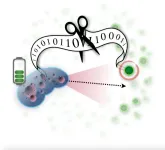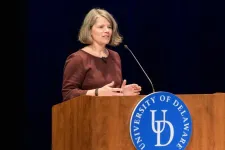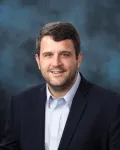(Press-News.org) Living systems—unlike non-living or inanimate objects—use information about their surrounding environment to survive. But not all information from the environment is meaningful or relevant for survival. The subset of information that is meaningful, and perhaps necessary for being alive, is called semantic information.
In a new paper published in PRX Life, University of Rochester physicists and their coauthors have, for the first time, applied this theory of semantic information to a well-known model of living systems in biology and ecology: an organism or agent foraging for resources.
Using a mathematical model, the researchers simulated how a foraging agent moves in an environment and collects information about resources. The simulations revealed what the researchers have called a semantic threshold: the critical point where information matters for the agent’s survival. Above this threshold, removing some information doesn’t affect survival, but below it, every bit of information is crucial.
By quantifying the correlations or connections between an agent and its environment, the researchers are helping to reveal the role of information in that agent’s ability to maintain its own existence.
Correlations as connections
Imagine a bird in its forest. It knows where to find the food it has stored to nourish itself. Say you move that bird 100 feet to a different part of the forest. “By doing so, you’ve cut some of the bird’s correlations or connections with its environment, but there are still enough correlations that it doesn’t affect viability, or the ability of the bird to survive,” explains Damian Sowinski, the lead author of the paper and a postdoctoral associate in the Department of Physics and Astronomy at Rochester.
Now, move the bird 1,000 feet away—or, more drastically, 1,000 miles away.
“Eventually, the bird is not going to know anything about its environment—all of the connections are cut. The viability of the bird goes from not really being affected to all of a sudden starting to plummet,” says Sowinski.
By contrast, moving a non-living thing like a pebble 100 feet, 1,000 feet, or even 1,000 miles away doesn’t fundamentally change the connections between the environment and the pebble. That’s because the pebble isn’t harnessing any information—relevant or irrelevant—about its surroundings to maintain or reproduce itself.
“One of the most basic things that life does is consume resources while navigating in space,” says coauthor Gourab Ghoshal, a professor of physics at Rochester. “These new findings indicate that our way of thinking—the idea that there is relevant and irrelevant information for survival—shows promise when applied in a simple resource-foraging model. The big question now is, will our way of thinking still apply with increasingly complex models?”
From particles to people: How does agency emerge?
Agency means acting with a purpose or responding to the environment in a non-random way. That requires making meaningful connections with the environment—interacting, reacting, and then deliberately acting in ways that are self-maintaining and self-producing.
So, when and how does agency—in an individual, in a group, or in a system—emerge?
“That’s a deep philosophical question,” says coauthor Adam Frank, the Helen F. and Fred H. Gowen Professor in the Department of Physics and Astronomy. “The whole point of advances in science is to take questions that used to be the domain of philosophical speculation and find a way to talk about them quantitatively. This paper does that in a mathematically rigorous way.”
Such a broadly applicable mathematical definition of semantic information could offer new insights across the disciplines—from biology to cognitive science, philosophy to physics—into how living and non-living systems are related. That’s one reason why the John Templeton Foundation, a philanthropic organization that funds academic scholarship on critical topics crossing disciplinary, religious, and geographical boundaries, has supported the team’s research.
“By using this language of information theory, we’re creating a bridge between the mechanistic narratives in the physical sciences and the more informational or behavioral narratives used in the life sciences,” says Sowinski.
He, like his colleagues, is energized to continue the team’s line of inquiry into the fundamental mystery of life. As Sowinski puts it, “Our work is a promising first step to answering a bigger question: What in the world causes a lifeless rock full of pebbles to eventually be covered with purposeful entities that are interacting meaningfully with one another and their environment?”
END
Researchers have applied the theory of semantic information to a realistic model capturing attributes of living systems—and found the critical point where information matters for survival
2023-11-28
ELSE PRESS RELEASES FROM THIS DATE:
Growing microtumors in a dish helps rapidly identify genes that drive tumor growth
2023-11-28
Researchers have identified a new way to screen genes that cause several different types of cancers to grow, identifying particularly promising targets for precision oncology in oral and esophageal squamous cancers.
The study, published in this month’s issue of Cell Reports, used 3-dimensional models of organ tissues called organoids to identify and test potential gene targets from The Cancer Genome Atlas.
“There’s a tremendous amount of data in The Cancer Genome Atlas, ...
New research compares five retinoids for anti-photoaging therapy
2023-11-28
Over the past decades, increasing evidences have demonstrated that five retinoids, including retinol (ROL), retinol acetate (RAc), retinol propionate (RP), retinol palmitate (RPalm), and hydroxypinacolone retinoate (HPR), can be potential therapeutic agents for skin photoaging. However, therapeutic efficacies and biosafety have never been compared to these compounds. This study aimed to determine the optimal retinoid type(s) for anti-photoaging therapy both in vitro and in vivo.
The data demonstrated that four retinoids (RPalm, RP, HPR and ROL) but not RAc were effective for anti-photoaging treatment at 5 μg/mL in vitro, with action mechanisms associated with antioxidative, ...
Can health, lifestyle changes protect elders from Alzheimer's?
2023-11-28
As more medications move toward federal approval for Alzheimer’s disease, a new study led by researchers at UC San Francisco and Kaiser Permanente Washington has found that personalized health and lifestyle changes can delay or even prevent memory loss for higher-risk older adults.
The two-year study compared cognitive scores, risk factors and quality of life among 172 participants, of whom half had received personalized coaching to improve their health and lifestyle in areas believed to raise the risk of Alzheimer’s, such as uncontrolled diabetes and physical inactivity. These participants were ...
Millions of kids in U.S. have inadequate health care coverage
2023-11-28
November 28, 2023-- Inadequate health coverage is a particular problem for commercially insured children, according to a new study released by Columbia University Mailman School of Public Health. The research shows that coverage gaps are affecting publicly insured children as well. Until now, prior research had focused on documenting rates and trends in insurance consistency for children covered by all insurance types. The findings are published in JAMA Health Forum.
“While uninsurance among children has generally been declining in the U.S., our results highlight the need for a renewed focus on making sure that children’s ...
NIH awards $2.6 million to Wayne State to develop new filtration platform for insulin administration
2023-11-28
DETROIT – A Wayne State University College of Engineering professor has received a $2.65 million award from the National Institute of Diabetes and Digestive and Kidney Diseases of the National Institutes of Health to develop a novel filtration platform to improve an advanced drug delivery device to optimize diabetes insulin treatments.
Subcutaneous insulin administration (SIA) technology has improved significantly over the past two decades, but SIA technology failure and underlying tissue damage caused by insulin phenolic preservatives ...
Mayo Clinic Board of Trustees approves plans to transform healthcare, improve experience for staff and patients, redesign Rochester campus
2023-11-28
ROCHESTER, Minn. — Mayo Clinic’s Board of Trustees has approved Bold. Forward. Unbound. in Rochester, a multiyear strategic initiative that advances Mayo Clinic’s Bold. Forward. strategy to Cure, Connect and Transform healthcare for the benefit of patients everywhere. It reimagines Mayo Clinic’s downtown Rochester campus and introduces new facilities with a combination of innovative care concepts and digital technologies that will give Mayo Clinic the ability to scale transformation ...
Threats against public health workers doubled during the COVID-19 pandemic
2023-11-28
While doctors and nurses were hailed as the frontline heroes of the COVID-19 pandemic, their counterparts in public health were experiencing threats. During the pandemic, threats against public health workers reached an all-time high. After the vaccine was released, those threats increased and changed in nature, according to a longitudinal study conducted during the first year of the pandemic by Jennifer Horney, founder of the University of Delaware Epidemiology Program in the College of Health Sciences.
The results, recently published in an open-access commentary in Public Health in Practice, show a strong need for expanded legal protections ...
Reducing inequitable health outcomes requires reducing residential segregation
2023-11-28
The U.S. must reduce racial residential segregation if it is to reduce racial disparities in health outcomes, according to a recently published study by researchers at Tufts University School of Medicine. The research on 220 metropolitan areas nationwide between 1980 and 2020 found strong links between trends in racial residential segregation and racial disparities in early death rates from a variety of causes.
The study is the first known to examine the association between changes in racial segregation over time ...
Manard named recipient of 2023 JAAS Emerging Investigator Lectureship
2023-11-28
Manard named recipient of 2023 JAAS Emerging Investigator Lectureship
Benjamin Manard, an analytical chemist in the Chemical Sciences Division of the Department of Energy’s Oak Ridge National Laboratory, has been selected for the 2023 Emerging Investigator Lectureship from the Journal of Analytical Atomic Spectrometry. JAAS is a publication of the Royal Society of Chemistry that shares innovative research on the fundamental theory and application of spectrometric techniques. Manard is the first winner of this award from a Department of Energy ...
Alcohol consumption may have positive and negative effects on cardiovascular disease risk
2023-11-28
FOR IMMEDIATE RELEASE
November 28, 2023
Contact:
Jillian McKoy, jpmckoy@bu.edu
Michael Saunders, msaunder@bu.edu
Lisa LaPoint, lisa.lapoint@tufts.edu
##
While past research has indicated that moderate alcohol consumption can lower one’s risk of cardiovascular disease (CVD), more recent studies suggest that moderate levels of drinking may be hazardous to heart health. ...




